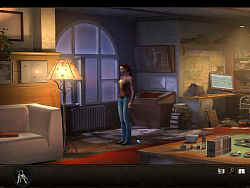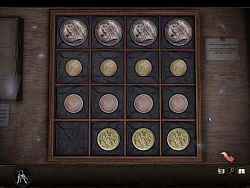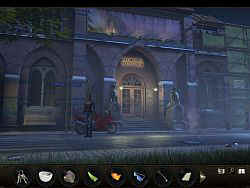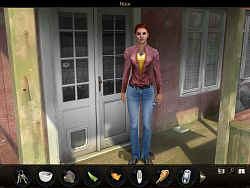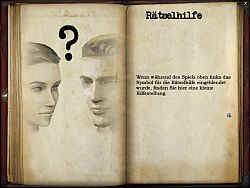Back to Adventure-Archiv starting page
![]() Diese
Seite auf deutsch
Diese
Seite auf deutsch
| Secret
Files Tunguska
Game language: German Homepage Age restriction: USK from 6 years
A review by MaryScots 1st September 2006
Apparently, there are gamers who can no longer bear the sight of sunken islands, goofy pirates and most especially hieroglyphics, veterans of pixel-hunting, whose eyes are sore longing for relief and masterminds as well as genre-newbies, who want to solve intelligent, logical and at the time entertaining and diversified puzzles. The graphics should be top-notch as well as a feast for the eyes even on older PC-generations. Point & click control is a must and action elements are usually uncalled-for. And there seem to be game designers, who noticed and decided to fulfil these very wishes. The mark was set high. A subject was chosen few had ever heard of – myself included – information was compiled from relevant forums about what PC-adventurers like/detest in terms of handling, graphics and puzzle-design, a publisher was found that supported everything and – Voilà! – here it is right in front of me, Secret Files: Tunguska, one of the most fervently anticipated adventure games of the year. Join me in checking the list and find out, whether any wishes remain unfulfilled. (Please note, that most of the information in this review is based on the German version and the English demo of the game so be sure to check back again for I will provide info on the full English version as soon as I receive it.)
Packing It sure looks beautiful, the cardboard-box with a shiny cover-flap from which the main characters watch us - challenging us. Inside you’ll find not only the DVD in a regular jewel case but also a detailed manual and – still shrink-wrapped – a booklet containing hints for the first part of the game. That’s a very good and reasonable idea for beginners in adventure gaming – all the others, though, should leave the shrink-wrap intact as long as they don’t get stuck hopelessly. This is more than with most recent games, already. But I was positively surprised when I found a nice extra in the shape of a middle-sized duplex-poster and a reduction-voucher worth 5 Euros for an X-Files DVD-Box. (Note: This is the contents of the German game box. The extras might vary depending on country of release!) But the most important thing of all is, of course, what is inside – I mean, deep inside – and that’s something new altogether for an adventure game, which leads me to...
The Story The event: on June 30, 1908 a number of people claim to have witnessed a lengthy bluish-white object falling from the sky over the central Siberian Tunguska region, then a light column of approximately 20 km height followed by a black mushroom cloud. Fact is, however, that a gigantic explosion with the force of 2,000 Hiroshima bombs took place as afterwards thousands of square metres in the region were scattered with uprooted and fallen trees. Even as far as 330 miles away travellers on the Trans Siberian Express still felt the impact of the blast. Since then, uncountable expeditions have tried to uncover what caused this disaster - without being able to deliver explicit results, though. A lot of preposterous theories both of a scientific and esoteric nature were spread worldwide ever since. Anyway, the only thing we know is, what the explosion left behind but not what has caused it. The story: one evening, our heroine Nina Kalenkow, a gorgeous young bike-mechanic and daughter of natural scientist Wladimir Kalenkow, enters her father’s office in Berlin to experience a bad surprise. Well, in fact she wanted to have a friendly father-daughter-chat again after some time, but finds his office at the museum in total chaos without a trace left of Dr. Kalenkow. His co-worker Max Gruber didn’t notice anything while working in his own office. He can’t imagine where his boss could have gone and Eddie, the concierge of the museum, is slightly drunk and agitatedly drivels unintelligible stuff about small men clad in black hooded cloaks hovering over the ground. The police isn’t very helpful, either and stubbornly advises Nina to sit and wait as it would be too early to report her father missing. Little later, however, Detective Kanski, a very unpleasant man, appears in Kalenkow’s office and asks Nina to go home, let him do his work and wait. But with Nina he’s telling this to the wrong person. Yet she does drive home to look for her father there but right after entering the house she is being knocked down and now she is absolutely certain that her father didn’t just go for a short walk around the block and forgot the time. She begins to search every nook and cranny hoping to find hints on Wladimir Kalenkow’s whereabouts and will soon discover that she does have some blank spots regarding her knowledge of his past. Apparently, he had anticipated his past to close in on him sooner or later and had wisely hidden some documents hoping that they would be found in due time by the right person. A person, who will have to travel around the world to assemble the fragments of events dating a long way back in order to get the big picture and who will find out about well guarded and dangerous secrets in the process. This person is Nina and the documents are kept in the Secret Files: Tunguska.
Setup and Controls By choosing a full installation we can copy all movie sequences to the hard drive so we will only need the DVD to start the game afterwards, while it has to remain in the drive when choosing the slim installation. I decided to go for the first option and after 5 minutes of unobstructed setup process - followed by a mandatory re-installation of DirectX 9.0c - I was ready to plunge into the adventure. There is a copy-protection included according to the info on the box but it wasn’t obvious, in other words, you don’t have to type in any code-keys. After launching the program we can start a new game from the main menu and later also load a saved game by clicking one of the small screens in the list provided with the name of the location and the date and time of saving. Under options you can also adjust the volume of music and sound effects, turn shadows, subtitles and integrated puzzle hints on or off as well as set the quality of the video sequences to high or low. In Secret Files: Tunguska everything is done by point & click. The normal cursor is a blue arrow, which will change into a white mouse-icon over hotspots and inventory items. A small eye for examining will be added to its right button and a small hand for all other actions such as manipulating and talking will be added to its left button depending on what is feasible at the spot or with the object in question. The mouse buttons will also be coloured green to draw our attention to the possible actions. And these are in fact all icons we need to remember. That’s what I call thoughtful minimalism and it facilitates entering the game even without having had a look at the instructions in the manual. It’s also very convenient that we can jump from one screen to the next by double-clicking but be aware that a lot of locations are larger than the visible screen, which scrolls along when letting the character walk on. Another thing I liked very much is that hotspots don’t stab your eyeballs like the light of a signal rocket but blend into the backgrounds naturally. Nevertheless, most of them are easily discernible as if seen on a photo and in case one still cannot find a specific item there’s always the so called Snoopkey, which is located on the space bar of your keyboard – the only key you might need aside from the mouse - and it’s also included as an icon in the constantly visible inventory at the bottom of the screen next to the menu exit button and the journal. When activated, the Snoopkey marks all available hotspots with a small magnifying glass and all exits from the screen by a big read arrow. So, it’s practically impossible to miss anything. Although, our characters can’t die in Secret Files: Tunguska it’s nice to know that saving is possible anytime and anywhere you want.
Graphics It’s mind-blowing. Really. To this day, the graphical presentation of Secret Files: Tunguska is pretty much the most perfect one I was ever allowed to admire in a 2,5D-adventure – many thanks for this! The intro sequence made me feel like watching a blockbuster already and the in-game movies really are a sight to be seen. This is where all the action went adventure gamers generally like to watch comfortably from their recliners rather than taking matters into their own hands. Camera use and editing leave nothing to complain about; only fast pans sometimes made me think my contact lenses were smudged. While playing and during dialogue sequences the camera remains fixed, though. Through motion-capturing the 3D characters’ movements are very natural and smooth both within film sequences as well as locations, into which they fit so harmoniously – almost as if someone had "painted" them into the backgrounds. Thanks to the surprisingly – and delightfully – low system requirements I was able to turn anti-aliasing up to 6x and also switch on V-Sync (via the configurations option of the game’s start screen), which brought the visuals to perfection and didn’t even cause the tiniest interference. But enough of technical chit-chat, let me gush over the pictures and their effect. Not only are the 2D-backgrounds designed in loving detail and very realistic - they are staged very lively, too. Fusionsphere Systems’ in-house developed engine renders all this possible. There’s motion everywhere in the shape of real-time 3D-elements, whether it is steam rising from a sewer, a little bird or even a butterfly dancing in the air (and growing larger visually, while approaching the observer just as if one was part of the scene). In an aquarium fish are swimming through rising bubbles and a fan rotates under the ceiling, trees softly sway in the wind and clouds pass across the sky, rain pours down and its drops rebound from the ground, the landscape flies by the window of a train and waves roll ashore. I could go on like this forever, although – with all this perfection – it does draw ones attention if for example windmills rotate in the background while in the location’s front area a tree stands absolutely motionless – well, we can’t always have everything, now can we. ;-) Another feature is dynamic lighting and shadows, which is impressing for the fact alone that you won’t notice them at once because they seem so real and natural and that – in my case – as a reviewer (who should have her eyes everywhere) one wonders about the developers’ self-restraint for not using this technique to an extreme. To give an example: Nina walks through a tunnel which is lighted only in one spot through a hole in its ceiling and only for the short time she needs to pass under that hole she will be covered in light just to appear darker again in the shadows. Of course, all characters also appear darker and paler at night compared to daytime scenes. Just like real life. Especially, Nina’s and Max’ – the main characters – body motions are very well animated, even though Nina could have used a little more flexibility in swinging her hips ;-) – but criticising this would result in splitting hairs - for she does crouch elegantly when picking up things and in one scene she has to strain so hard to walk against the wind that I pressed my finger even stronger on the mouse button in an unconscious attempt to support her efforts. And also the characters’ facial animation is quite lifelike, although you can’t always see it properly due to the perspective and the visual distance. Merely the NPC’s are slightly in disadvantage in terms of resolution compared to the main actors – not in a dramatic way but they don’t have such clear contours and appear a little more plain and colourless.
Dialogues, voice-overs and sound Now, there isn’t just plenty to see in Secret Files: Tunguska but just as much to hear. The dialogues, whose topics we choose via small pictures from the inventory bar are very diverting, not too long but interlaced with all the necessary information to ensure our process and to relate interesting background bits of the story while at the same time the choice of words stays down-to-earth. What I mean is that - apart from a handful of scientists - nobody overuses terms. Just to give you a small example: Nina finds a portable cassette player and only needs the batteries, her comment: "…I don’t want to schlepp around any unnecessary junk." (Being a German I can only say that the wording used for example by Nina is one that I would use myself if I was in the same situation. And although the English translation does sound very good to me I won’t claim to know what you would say as a native English speaker so you’ll just need to find out that for yourself.) Next to the conversations Nina’s and Max’ comments are remarkable, too. They rarely repeat themselves - so you don’t have to fear bleak phrases like "This doesn’t work!", which uncountable adventures offer by the dozen – but usually rather give us a subtle hint as to why something will not or will not yet work. What you will hear often if you check all the available hotspots are funny and/or allusive comments, for example when Nina finds a book at her father’s place: "A biography of George Shrub! Since when does my father read such a trash?" (So, they really took care to also translate the jokes in a way that makes sense. And I am very curious what they made of the rest outside the demo version, since like you, dear readers, I still have to wait for the full English version to be released.) For players, who have to rely on subtitles or only just like to read along I have good news too. The texts reproduce the spoken or thought words exactly and even free of typos or content mistakes. You can’t repeat conversations but you will find all the important information in Nina’s journal. The professional speakers, a number of them well-known dubbing-actors in Germany, and the voice direction have all delivered excellent work – accentuation, cues, everything is very well done. The voices match the characters terrifically and even the little girl in front of the museum, which in the German version sounds like a grown woman imitating a child’s voice (actually it’s the German voice of yellow comic-heroine Lisa Simpson and it simply sounds bad), thankfully has a matching voice in the English version. Speaking of bad, this is also true for a joke in the shape of a conversation taking place in Ireland between Max and a female NPC and which doesn’t relate any additional information to the story (it might even confuse the uninitiated) and, what’s worse, it’s not very funny, either. It might have been intended as a kind of easter egg in the first place but only comes across as a sorry form of ‘product’ placement. The end credits would have been a better place for this and instead another perky innuendo from the NPC’s lips (i.e. relating to another adventure set in a similar surrounding) might have done the trick. Apart from the lively animations I am just as much taken with the matching sound effects, which especially account for the powerful atmosphere of the game. Almost everything that moves also has its own distinct sound – and in surround sound, too – so, with the right speakers you will even more feel like being part of the events. :-) Bees are buzzing in a garden, rain constantly patters down in Ireland (where else?!), birds sing, you can hear the wind-rustled leaves of the trees while just beneath them the water of a small river ripples over the stones and in a building you just broke into distant footsteps make you slightly nervous. Oddly, our characters alone are walking around without a sound but it took some time until I noticed, I have to admit. A lot of effort was put into bringing the gameworld as close to reality as possible and for me it worked 99%. The background music is not exactly what I would call groundbreaking but maybe this really one of it’s best assets. On all accounts, it does add to the atmosphere with its instrumental tracks conveying peaceful as well as threatening moods without becoming too prominent or even interfering with our thinking. There was one specific track heard in some locations, though, which struck me as odd because I recall hearing an almost identical one in The Moment of Silence. The reason could be that the developers also commissioned the Mainz-based company Dynamedion to do the score as did the MoS-developers House of Tales. That track sure is very good but at the same time so striking that some adventure fans might find it strange to hear it again in another game. To me, at least, it was. I don’t blame the developers but from my point of view it’s bad advise by the composers.
Puzzles If you happen to love inventory- and object-based puzzles as much as I do Secret Files: Tunguska won’t be a disappointment at all. In over 100 locations numerous objects wait for you to pick them up, examine them, manipulate or combine and use them. In general, our protagonists will collect anything that hasn’t taken to the trees on the count of three. And in case, they don’t want to pick up something or apply it according to our ‘order’ they will let us know why so we can keep this thing in mind to check back again later. Our alter egos can only proceed in the game once they did all the necessary stuff. I was pleased that my testing for dead ends came up with nothing. I once left an item were I saw it on purpose because I knew (from the preview version) that I would need it only at a point in time when I wouldn’t be able to get back to where I discovered it. And - Lo and behold! – I later found this thing again where I finally needed it. It’s also possible to use an item twice in a logical manner or to be more precise, if you need to wet something you can do this directly at the water source or you can carry the water with you in a container and then combine it with the object in question. A puzzle-design as elaborate as this eliminates frustration and should therefore find honourable mention here. You will, however, encounter inventory-based puzzles of the more complicated kind daring you to think outside the box, which is required especially when our heroes can only solve a problem through teamwork. Each of them then collects what he/she can find (while you can switch between the two via an additional icon), manipulates the items and/or hands them to the other if need be. While the two are on separate missions and you get stuck with one character you can also try to proceed with the other by switching locations via said icon. So you’ll never get bored despite a certain linearity, which is important in terms of narration. You’ll also find a number of logic tasks presented as sequence-, code- and mechanical-puzzles, although this kind of challenge has been implemented very carefully and when encountering them a red question mark in the upper left corner of the screen will inform us that we can now find hints on the last page of the journal before we despair. This support, however, is only provided when it is activated in the main menu. All in all the puzzles are very practical throughout the game and they never come across as if the story had been written around them. The developers consciously abandoned unpopular obstacles such as mazes, arcade elements, timed sequences as well as those tasks, which afford hours of studying texts. It was planned to let the level of difficulty increase slowly but steadily, however, this didn’t work out completely for in the last chapter I became quite clueless and began to try and combine each and everything, even the journal and the Snoopkey weren’t very helpful anymore. Another reason might have been that Nina’s comments on some objects lost their expressiveness and all this led to a decrease in suspense. It’s unfortunate but not the end of the world as I did manage in the end – only part of it by trying instead of logical conclusion. One last thing, though, aside from the necessity to examine everything in order to find clues and objects, it simply is highly entertaining to take a close look at all the hotspots because you can find so many allusions to other adventures, movies, people and the like in the shape of comments as well as images. For this alone it would be a shame to rush through the game as obviously a lot of players feel the need to do, nowadays.
Summary Having played titles like Fahreheit and Dreamfall, I have to admit that I am not that pigheaded anymore regarding my definition of what an adventure game has to be like. For even action and arcade elements - if well made and implemented - can certainly be captivating and provide lots of fun. Nevertheless, they aren’t necessary in this genre and I, too, have been dreaming of a classical point & click adventure preferably getting everything right. And I mean everything! :-) Secret Files: Tunguska does get dangerously close to my perception of a perfect adventure game based on a graphic design I can only call breathtaking, an almost perfect, highly atmospheric soundscape and voice-overs, a logical puzzle-design – apart from the final location – combined with easily accessible controls and last but not least a thrilling and captivating story, which I can only criticise for giving away a little too early where everything leads. Although, I also demand an appropriate duration of a near perfect adventure game I have to say that I was very well entertained spending approximately 22 hours with Secret Files: Tunguska and therefore I can only recommend it warmly to every player from beginner to master. Score: 90%
If you want to know more about the facts and theories regarding the Tunguska event you will find information in the game manual or you might want to check Wikipedia. :-)
Adventure-Archiv rating system:
Minimal system requirements:
Played on:
Copyright © MaryScots for Adventure-Archiv, 1st September 2006
|
Click screenshots to magnify
More screenshots
|
|

